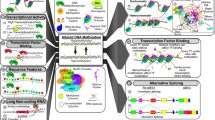Abstract
Green-striped burrowing frogs, Cyclorana alboguttata, survive droughts by entering a metabolic depression called aestivation, characterised by a reduction in resting oxygen consumption by 80%. Aestivation in C. alboguttata is manifest by transcriptional silencing of skeletal muscle bioenergetic genes, such as NADH ubiquinone oxidoreductase 1, ATP synthase and superoxide dismutase 2. In this study, we hypothesised that aestivation is associated with epigenetic change in frog muscle. We assessed mRNA transcript abundance of seven genes that code for proteins with established roles in epigenetically-mediated gene silencing [transcriptional co-repressor SIN3A, DNA (cytosine-5-) methyltransferase 1, methyl CpG binding protein 2, chromodomain helicase DNA binding protein 4, histone binding protein rbbp4, histone deacetylase 1 and nuclear receptor co-repressor 2] using qRT-PCR. These seven genes showed a modest (1.1–3.5-fold) but coordinated upregulation in 6-month aestivating muscle. This reached significance for SIN3A and DNA cytosine-5-methyltransferase 1 in standard pair-wise comparisons (p < 0.05), and the candidates as a whole when analysed by Fisher’s combined probability test (p < 0.01). These data are consistent with the hypothesis that the transcriptional silencing and metabolic depression that occurs during seasonal dormancy are associated with chromatin remodelling, and present a novel example of an environmentally induced epigenetic modification in an adult vertebrate.

Similar content being viewed by others
References
Berriel Diaz M, Lange M, Heldmaier G, Klingenspor M (2004) Depression of transcription and translation during daily torpor in the Djungarian hamster (Phodopus sungorus). J Comp Physiol B 174:495–502
Eddy SF, Morin P Jr, Storey KB (2006) Differential expression of selected mitochondrial genes in hibernating little brown bats, Myotis lucifigus. J Exp Zoolog A Comp Exp Biol 305:620–630
Flanigan JE, Withers PC, Fuery CJ, Guppy M (1993) Metabolic depression and Na+ K+ gradients in the aestivating Australian goldfields frog, Neobatrachus wilsmorei. J Comp Physiol B 163:587–593
Fleischer TC, Yun UJ, Ayer DE (2003) Identification and characterisation of three new components of the mSIN3A corepressor complex. Mol Cell Biol 23:3456–3467
Fuks F, Burgers WA, Brehm A, Hughes-Davies L, Kouzarides T (2000) DNA methyltransferase Dnmt1 associates with histone deacetylase activity. Nat Genet 24:88–91
Grundy JE, Storey KB (1999) Antioxidant defence and lipid peroxidation damage in estivating toads, Scaphiosus couchii. J Comp Physiol B 168:132–142
Hudson NJ, Franklin CE (2002a) Maintaining muscle mass during extended disuse: aestivating frogs as a model species. J Exp Biol 255:2297–2303
Hudson NJ, Franklin CE (2002b) Effect of aestivation on muscle characteristics and locomotor performance in the green-striped burrowing frog, Cyclorana alboguttata. J Comp Physiol B 172:177–182
Hudson NJ, Lavidis NA, Choy PT, Franklin CE (2005) Effect of prolonged inactivity on skeletal motor nerve terminals during aestivation in the burrowing frog, Cyclorana alboguttata. J Comp Physiol A 191:373–379
Hudson NJ, Lehnert SA, Ingham AB, Symonds B, Franklin CE, Harper GS (2006) Lessons from an aestivating frog: sparing muscle protein despite starvation and disuse. Am J Physiol Regul Integr Comp 290:R836–843
Jaenisch R, Bird A (2003) Epigenetic regulation of gene expression: how the genome integrates intrinsic and environmental signals. Nat Genet Suppl 33:245–254
Larade K, Storey KB (2007) Arrest of transcription following anoxic exposure in a marine mollusc. Mol Cell Biochem 303:243–249
MacDonald JA Storey KB (2006) Identification of a 115kD MAP-kinase activated by freezing and anoxic stresses in the marine periwinkle, Littorina littorea. Arch Biochem Biophys 450:208–214
Morin P Jr, Storey KB (2006) Evidence for a reduced transcriptional state during hibernation in ground squirrels. Cryobiology 53:310–318
Pile LA, Spellman PT, Katzenberger RJ, Wassarman DA (2003) The SIN3 deacetylase complex represses genes encoding mitochondrial proteins: implications for the regulation of energy metabolism. J Biol Chem 278:37840–37848
Pyne S, Futcher B, Skiena S (2006) Meta-analysis based on control of false discovery rate: combining yeast ChIP-chip datasets. Bioinformatics 22(20):2516–2522
Rider MH, Hussain N, Horman S, Dilworth SM, Storey KB (2006) Stress-induced activation of the AMP-activated protein kinase in the freeze tolerant frog Rana sylvatica. Cryobiology 53:297–309
Rountree MR, Bachman KE, Baylin SB (2000) DNMT1 binds HDAC2 and a new co-repressor, DMAP1, to form a complex at replication foci. Nat Genet 25:269–277
Sellars MJ, Vuocolo T, Leeton LA, Coman GJ, Degnan BM, Preston NP (2007) Real Time RT-PCR quantification of Kurama shrimp transcripts: a comparison of relative and absolute quantification methods. J Biotechnol 129(3):391–399
Storey KB, Storey JM (1990) Metabolic rate depression and biochemical adaptation in anaerobiosis, hibernation and aestivation. Q Rev Biol 65:145–174
Symonds BL, James RS, Franklin CE (2007) Getting the jump on skeletal muscle disuse atrophy: preservation of contractile performance in aestivating Cyclorana alboguttata (Gunther 1867). J Exp Biol 210:825–835
Tan SH, Reverter A, Wang Y, Byrne KA, McWilliam SM, Lehnert SA (2006) Gene expression profiling of bovine in vitro adipogenesis using a cDNA microarray. Funct Integr Genomics 6(3):235–249
Williams DR, Epperson LE, Li W, Hughes MA, Taylor R, Rogers J, Martin SL, Cossins AR, Gracy AY (2005) Seasonally hibernating phenotype assessed though transcript screening. Physiol Genomics 24:13–22
Acknowledgments
We wish to thank David Tremethick (ANU) for pointing us in the direction of the SIN3A co-repressor, Bill Barendse and Toni Reverter-Gomez for statistical advice and Beth Symonds for catching and maintaining the frogs. This work was funded by a CSIRO Postdoctoral Fellowship to NJH, and supplemented by an Australian Research Council Discovery Grant to CEF.
Author information
Authors and Affiliations
Corresponding author
Additional information
Communicated by I.D. Hume.
Rights and permissions
About this article
Cite this article
Hudson, N.J., Lonhienne, T.G.A., Franklin, C.E. et al. Epigenetic silencers are enriched in dormant desert frog muscle. J Comp Physiol B 178, 729–734 (2008). https://doi.org/10.1007/s00360-008-0261-0
Received:
Revised:
Accepted:
Published:
Issue Date:
DOI: https://doi.org/10.1007/s00360-008-0261-0




